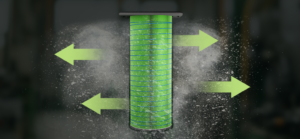One of the most important aspects of dust collection is having the proper filter media for the job. Controlling air quality by containing airborne dust particles benefits the health of workers, safeguards products processed at the facility and protects equipment. Here are key considerations to make sure your dust collector media is right for your application.
Quality Filters Versus Inexpensive Filters
There are two main aspects of a filter cartridge – the media inside it and the construction. Regarding the media itself, sometimes an inexpensive product is the right choice. For example, some processes require frequent filter change-outs and only need to contain a certain size particulate, so a lower-priced filter media is appropriate. However, inexpensive filters have weaker construction, which can lead to premature failure and dust escaping from the collector. With quality filters, you can incorporate the proper media, whether it’s expensive or inexpensive. Also, quality filters are well-constructed, ensuring performance reliability.
Processes Benefitting from Quality Filters
It’s important to use quality filters if you need to both capture waste dust and protect the integrity of your end product. A great example is food processing. High-quality dust collector filters control dust to maintain air quality and prevent contamination of food products. Another example is metal processing, where surface finishes on metal must be clean and smooth. Quality filters are also important in pharmaceutical and chemical manufacturing, which could release toxic dusts that create an unsafe work environment and foul products.
Selecting Filter Media
The two main factors to consider when selecting filter media are the characteristics of the dust particles and of the manufacturing process.
Regarding dust particles, it’s important to have your dust tested, so you can determine characteristics like size, shape and combustibility. Size indicates how harmful they are. Particles with a diameter of 1.0 microns or less can cause significant damage, because they can penetrate the lung barrier and enter the blood system. If the particles have an abrasive shape, such as crystalline with jagged edges, they will quickly damage the media and will need to be removed from the air stream before they reach the filters. If your dust is combustible, you’ll need to use filter media treated with compounds that deliver special performance properties like fire retardancy.
When evaluating the manufacturing process, note that certain media performs well only up to certain temperatures. And if the air is humid, some dusts will absorb the moisture, become sticky and plug up the filters. Certain processes, like plastics manufacturing and machining produce static electricity, which can create a charge that could ignite the dust and trigger an explosion.
Types of Filter Media
There are basically two basic types of filter media in dry dust collecting. The first is a nonwoven cellulosic blend called cellulose. Then there is a synthetic polyester or a polyester silicone blend, which is referred to as spunbond.
Cellulose is the most cost-effective media generally with a blend of 80% paper and 20% synthetic fiber. It works well in most applications and has a fairly high working temperature. Spunbond media is 100% synthetic fibers, so it can perform at higher working temperatures. It is very durable and recovers well when introduced to moisture during a manufacturing process.
Both media types can be treated to add performance properties like fire retardancy, moisture repellency, nanoparticle capture.
For more filter media information, check out the segment “Proper Media Selection” by Randi Huckaby, Camfil APC’s Product Manager for Dry Filtration, on Camfil’s Let’s Talk Clean Air podcast.





